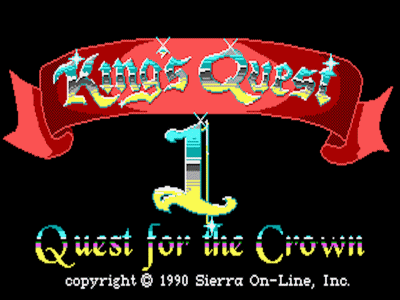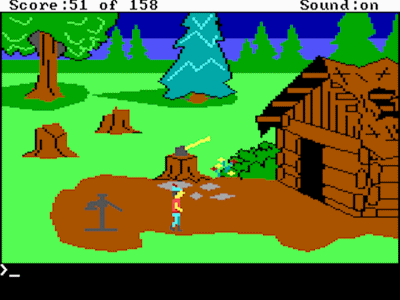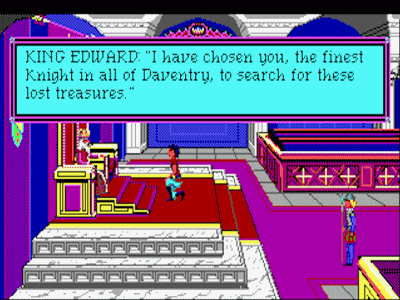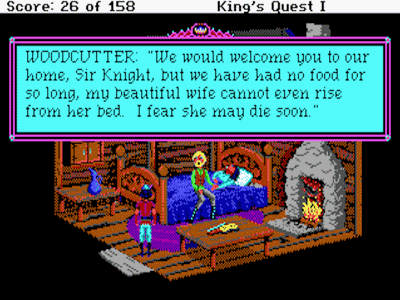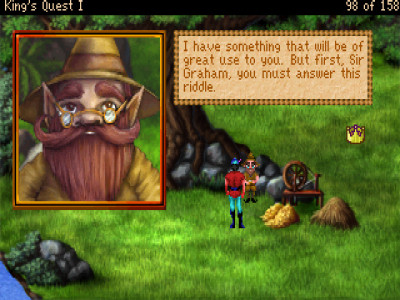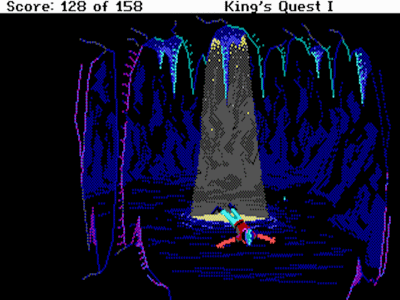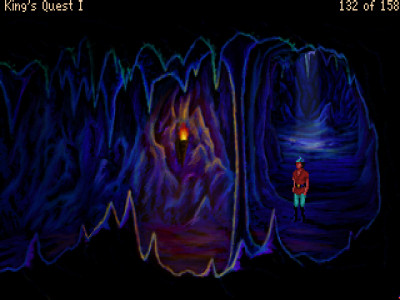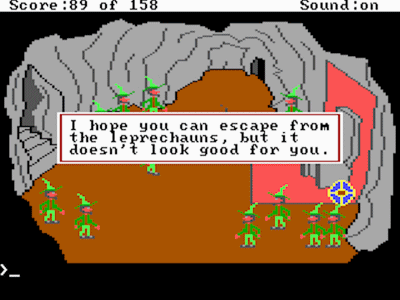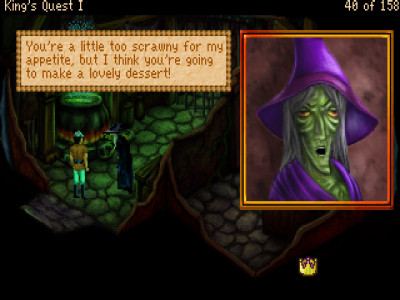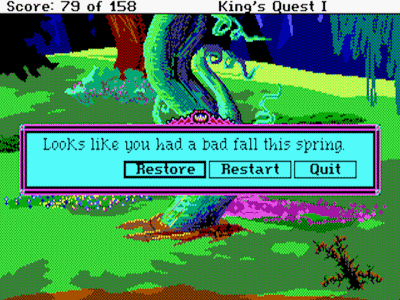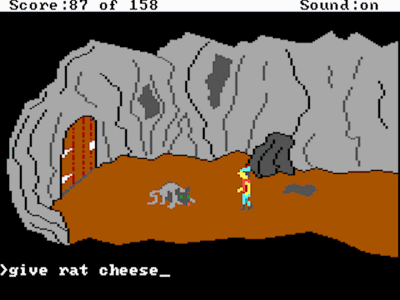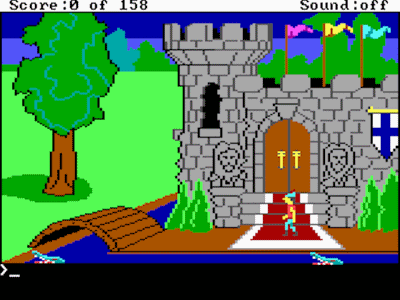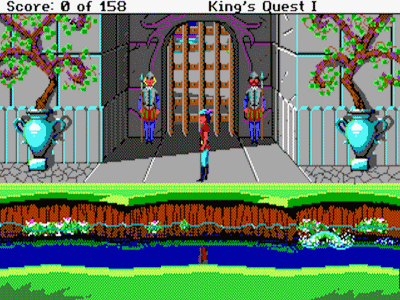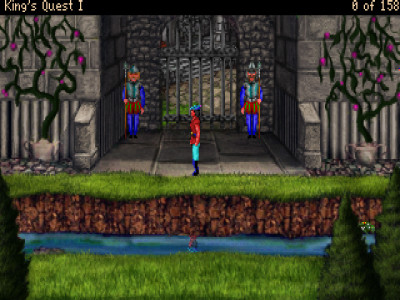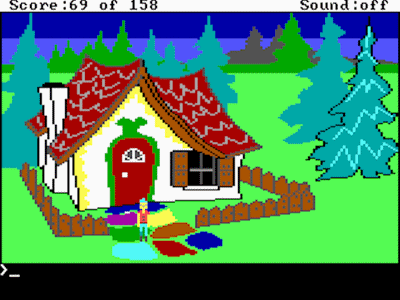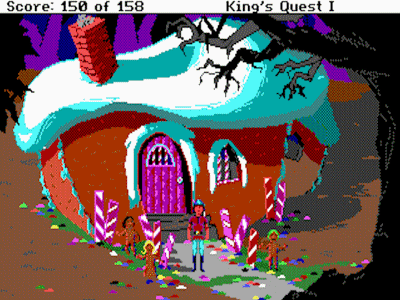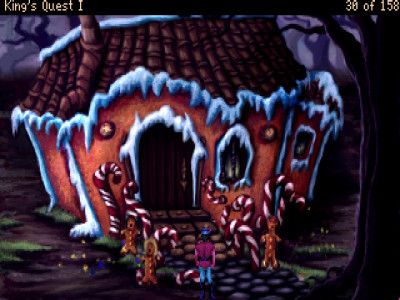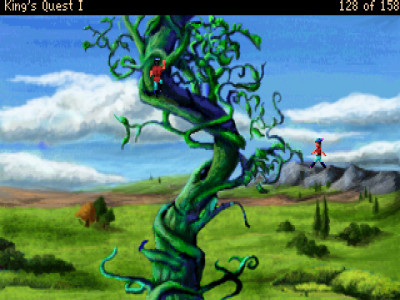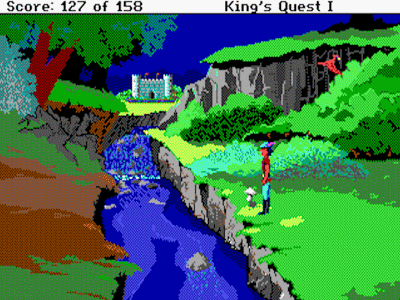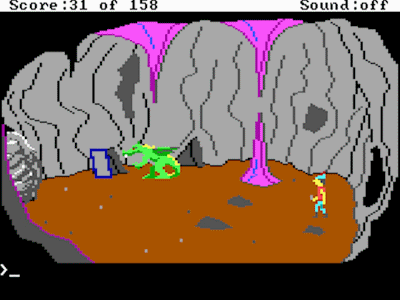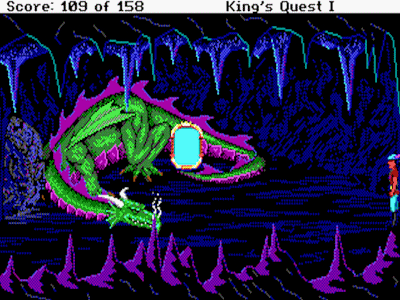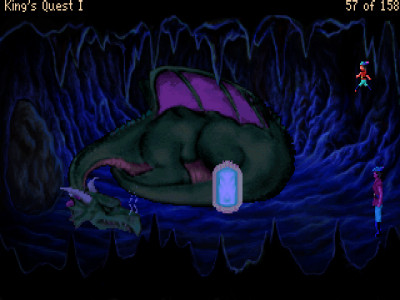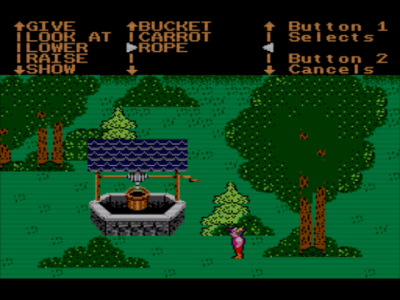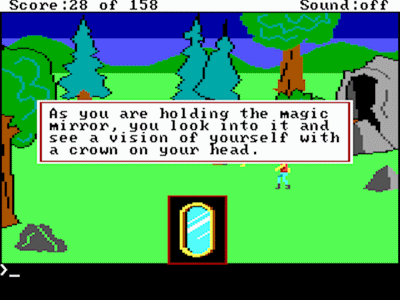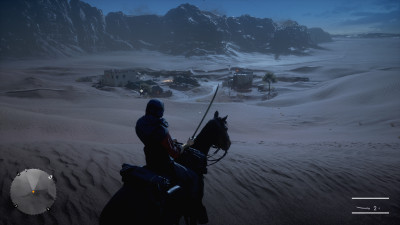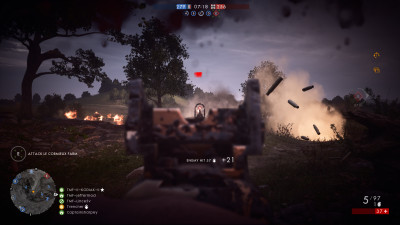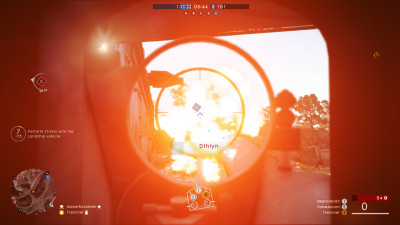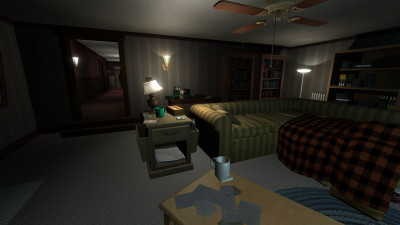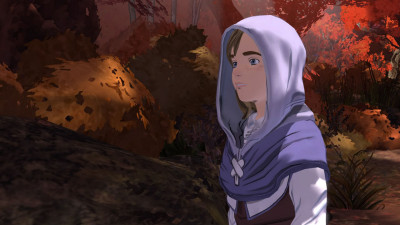I’ve written about playing each entry of Telltale’s series of The Walking Dead adventure games here and, for the most part, really enjoyed all of them. I’ve been meaning to go back and play some of their other, similar titles for a while now, and thanks to a nice sale on the Xbox Store and a little bit of luck, I ended up playing three of them more or less back to back.
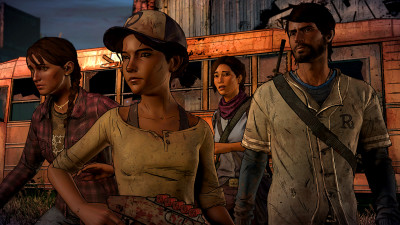
“Our two main characters, Clem and Javi.”
Since we are basically hooked on the series, my girlfriend and I made plans to dive into the latest installment of The Walking Dead, The Walking Dead: A New Frontier, as soon as we found out the release date for it. We picked it up on the Xbox One and, like The Walking Dead: Michonne before it, we decided to play each episode as it was released.
The first thing I need to mention, especially after how my game log entry about it devolved into a bit of a rant, is that this version of this particular game (yay, qualifiers!) has none of the horrendously unacceptable, bullshit performance issues and other bugs that plagued us on the Xbox 360 version of The Walking Dead: Michonne. Telltale apparently put a lot of work into their engine in advance of Batman: The Telltale Series, work which carried on to A New Frontier. At fucking last, Telltale! No more issues of the engine constantly interrupting my enjoyment of the game; it ran silky smooth.
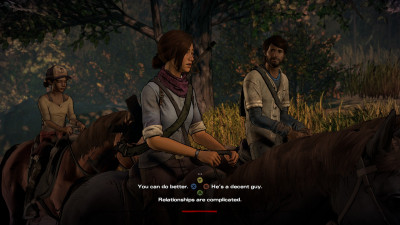
“More thrilling dialog choices…”
With the engine upgrade also comes an upgrade to graphical capability, and with it, a big shift in art style. The TWD games have been stylized to look like the comic books the franchise is based on since the beginning but A New Frontier does something totally new by filling in the space between the ink brush strokes with some real time lighting applied to its 3D models. No longer do characters look flat, but instead look just a tiny step closer to realistic. While this change is subtle at first glance, in direct comparison the change of art style is actually pretty massive. It’s a little odd upon closer inspection, mixing two completely different, opposing even, styles of shading, but it somehow works and most of the time I think A New Fonrtier looks spectacular.
Onto the story. Notably, you don’t play as Clementine too much this time around. In fact, she’s much more of a side character, which I’m sure will disappoint a lot of series fans, and results in the game feeling a bit more like a side story, ala TWD: Michonne or the 400 Days episode. Perhaps this was intended, I mean, this isn’t called “The Walking Dead: Season 3” after all. Nonetheless, I found cocky and/or warmhearted Javier “Javi” García to be quite a fun character to play. Javi is dealing with a constant, morally difficult conflict between devotion to family, a family which is, in itself, full of its own, similar conflict, and more selfish pursuits, which feel equally justifiable. In either case, Javi’s motives are relatable, which makes the dramatic choices you have to make all that much more nail-biting.
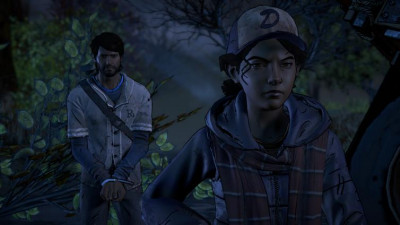
“Well, I didn’t say they were BFFs…”
Besides less of a focus on Clem, another big complaint leveled against A New Frontier seems to be what people feel is a decreased sense of player agency. From misleading choices, to those choices not really impacting the overall narrative as one might expect. Given that most of these complaints are from fans of the previous games, it shouldn’t be necessary to go into the way that practically all of these Telltale adventure games since the first season of TWD lack any major “branching”, or how the effects of most of your decisions are, in fact, only clever tricks to make you feel like you’re having a huge impact on the course of the story. Instead, I believe the intended effect is exactly what happened to me with A New Frontier: I didn’t really notice. Instead, I enjoyed the effect I had on how my character behaved, and how his behaviors were perceived and impacted the behaviors of the characters around him in the moment, regardless of whether decision A moved to the story in a different direction than decision B. To put it another way, these games are about characterization, not consequence.
All in all, we really enjoyed A New Frontier. While it didn’t impact me quite as much as any of the other games in the series, immediately after finishing it, I’d easily hold it up alongside Season 1 and Season 2. Now that some time has passed, it really feels a bit more like a side story, as mentioned, and that has me curious about how Telltale plans to follow this up. Most likely, we’ll see an actual third season that more closely follows Clementine, with the events of A New Frontier having little impact on its story.
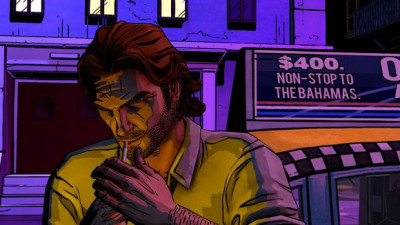
“Our titular hero, Bigby Wolf.”
Jonesing for more during the agonizingly long the waits between episodes of A New Frontier, we finally played through the much lauded The Wolf Among Us. The Wolf Among Us came out right after the highly successful season 1 of The Walking Dead, and, to Telltale’s credit, was well regarded as a follow-up. In fact, judging from time spent scouring various forum topics, ranking videos, etc., it remains a lot of people’s all time favorite Telltale game. It was only after that very positive reception was firmly in-place that I decided I wanted to play it. The main reason I had held off for so long was that the whole concept of playing some sort of gritty, realistic portrayal of fairy tale characters seemed utterly ridiculous to me. I mean, you play as a dude named “Bigby Wolf” who is, in fact, the big bad wolf? Come on!
The truth is, between the art, which is similar to TWD’s take on translating traditional, still comic book imagery into textures on 3D polygons, but so much more colorful and vibrant, the amazing gritty 1980s New York City atmospheric, the synth-laden soundtrack, and the whole film noir, detective trying to piece together a mystery vibe of the basic plot, TWAU was actually a very easy game for me to get into. The whole fairy-tale meets gritty reality premise is introduced slowly and enough of the details are left vague that rather than feeling to forced and silly it actually manages to feel come across as intriguing. Once you start to learn more about them, the characters are also quite interesting, which is kind important for a Telltale adventure game.
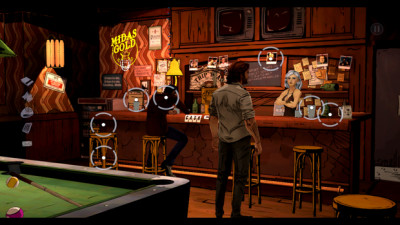
“One of the few graphical adventure game throwback exploration sections.”
Specific criticisms? Well, first, unlike A New Frontier’s updated engine that I just complimented Telltale on, I was surprised to find out just how badly the Xbox One version of TWAU, using this much older version of the engine, suffered from poor performance. It wasn’t nearly as bad as my experience with TWD: Michonne on Xbox 360, but it was still damn frustrating at times and unquestionably hampered my enjoyment of the game. The main issues that I found absolutely unacceptable were occasional moments when dialog was cut short, or even muted entirely. That’s a big problem on such a dialog driven, narrative heavy game. This type of shit really should have never made it past QA.
I also take some issue with the story itself, and I’ll be vague to avoid spoilers. It might have related to the choices we made during our particular playthrough, and maybe my own perception of my character and the plot as it developed, but the way the main plot wrapped up felt a little rushed. Specifically, during the trial and how I chose to handle it, it felt more like Bigby was on trial than defendant, and various important aspects of the crimes our antagonist was being condemned for, and even additional crimes, weren’t even brought up, which might have affected that. Then, the scene just sort of… ended. I also wasn’t a big fan of the very end, which I honestly didn’t get at first. It was only after scratching my head and doing a little reading online that I figured out what they were attempting to convey, which of course makes the whole thing feel more hamfisted than clever in its execution. It also felt strange that there wasn’t a more solid sense of closure between Bigby and Snow, when there definitely should have been.
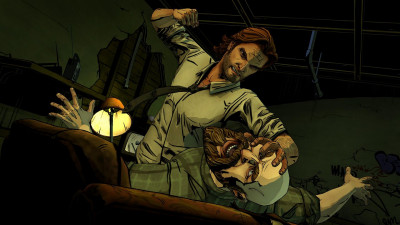
“Some people just need a beat down.”
Oh, and the incredibly one dimensional character of Bloody Mary, with her silly comic book villain dialog, when compared to the texture of the other characters and the overall tone of the game, came across as exceedingly out of place to me. Maybe she’s as equally boring and boilerplate in the comics, I don’t know, but it took me out of the game just a little every time she made another lame appearance.
It doesn’t sound like it, but I really liked the game, and probably wouldn’t be so critical of it if I hadn’t gone into it with extremely inflated expectations. Bloody Mary aside, I think many of my misgivings about the plot could be easily smoothed over by some proper treatment in a sequel. Hell, I might have a more positive impression of it just by replaying it and making some different choices, for that matter.
Finally, after completing TWD: A New Frontier and The Wolf Among Us, spurred on by both my enjoyment of those two games and of the completion of season 7 of the wildly popular HBO series, I decided to finally cross Game of Thrones off of my backlog. We had both separately completed the demo of the first episode of Game of Thrones on the Xbox 360 around the time it was originally released, but she didn’t really get into it very much, and while I wanted to play more, I couldn’t quite work it into my schedule at the time.
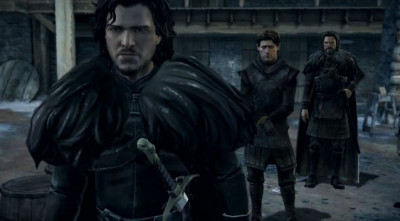
“Back to the wall… hey wait, is that Jon Snow?!”
Game of Thrones came right after TWD Season 2 as well as the fan favorite Tales of the Borderlands, which in turn were right on the heels of the first season of The Walking Dead and the aforementioned The Wolf Among Us. With that in mind, I didn’t know how much of an enjoyable experience this would be, engine-wise. Thankfully, some odd glitches and slow loading times aside, the engine used in the Game of Thrones seemed to run pretty decently on my Xbox One. Definitely not the shit-show that TWAU was, at least.
The art style takes an odd turn from the two other games. Models still have a similar, cartoony stylization to the TWD and TWAU, it completely eschews the comic book styled textures and shading of those games. Instead, it attempts to look more like it was hand painted by applying some sort of a filter over everything. Sometimes it looks great, but for the most part it really didn’t seem to achieve the effect I imagine they were going for. Odder still, the slightly more realistic approach to the graphics goes off the rails when introducing characters that we’re familiar with from the Game of Thrones HBO series, fully modeling the characters after their actors, and at times, producing an unsettling “uncanny valley” effect. They may not look bad in the screenshots here, but in motion? Ick.
Besides their likenesses, a lot of the actors from the series also lend their considerable acting talents to help voice their characters. This is, by far, one of the more enjoyable parts of the game for big Game of Thrones fans. Then again, the soundtrack, inspired by the music of the series, is also excellent, and there is a lot more fan service where those things came from; innumerable references to both the HBO series AND George R.R. Martin’s A Song of Ice and Fire book series abound. This game really is a treat for fans, and goes quite deep into immersing the player into the setting. Perhaps too far…
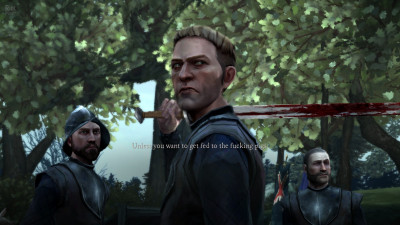
“FUCK this fucking guy.”
You see, this game is one of the most vicious video games I’ve ever played. It’s true to the setting and the tone of the source material, no doubt, but playing as characters in the world, and characters who aren’t exactly being dealt a lot of winning hands to boot, is incredibly oppressive. From the very first episode, House Forrester suffers terrible turn after terrible turn, and every decision you make is met with another terrible outcome. After 6 episodes, it almost starts to feel like some sort of abusive relationship. It’s a common complaint about the game, with some people even claiming they couldn’t make it through to the end because of how harsh it felt, like you were being constantly kicked around by everybody, at every turn.
On top of that, a lot of people complained that they didn’t feel like they possessed the agency to get themselves out of those terrible situations. Always on the defensive, your characters are constantly having to decide between trying to stand up for their family and their honor, or submitting in service of possibly keeping the situation from somehow getting even worse. The decisions in this game are definitely extremely difficult, and just like other Telltale games, there isn’t necessary a correct choice, as there are bleak consequences no matter how you choose to play. This didn’t hamper my enjoyment of the game, however, as like I said in regards to A New Frontier, Telltale’s games are more about experiencing the characterization of and resulting from your choices, not so much the direct consequences of those actions on the overall story.
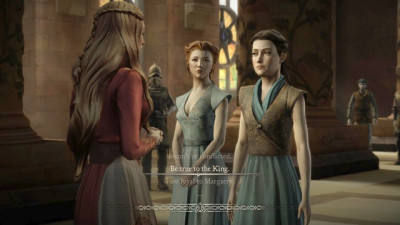
“Caught between Cersei and Margaery, of course you should lie.”
Speaking of characterization, one thing that did bother me a little was the fact that, as I alluded to, you play multiple characters. Just like the books and the HBO series, the game constantly has you hopping around between different major characters. It definitely keeps things interesting, exposing you to a lot more variety in scenarios and settings, but playing so many different characters also takes a little away from really getting to know your character, and sometimes interrupts flow of the story. By the time you make it to the end of the last episode this issue has mostly gone away, but it was still notable to me, particularly since I initially went into the game with a vague plan of how I’d try to roleplay my (single) character. Oops.
Another common complaint and one that stuck out to me as well, is that the noble house you play as, House Forrester, closely parallels House Stark, the primary characters of the books and HBO series. Not only are the Forresters another northern house who suffers from similar circumstances as the Starks, but individually, they each align with the Starks just a little too well, with the biggest departure being the character of Asher Forrester, who really doesn’t have an analog. This is only the smallest of complaints, and the characters do mostly come into their own as the game progresses, but probably not coincidentally, Asher was my favorite character to play as.
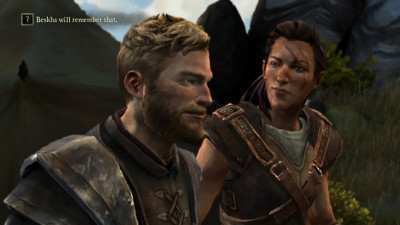
“Asher Forrester and Beskha.”
While I did agree with most of those complaints, overall I liked the game. Its brutality left me with many of the same type of “ohhhhh shit!” moments as the source material, which is ultimately a good thing. As the credits rolled on the final episode, I found myself thinking a lot about how they could possibly have a sequel to Game of Thrones, considering that House Forrester was almost entirely decimated, and so many important characters were killed or otherwise completely screwed over. Alas, it didn’t seem worth dwelling on given that Game of Thrones seemed to have been relatively unpopular, and a sequel seemed doubtful.
Well, much to my surprise Telltale announced that we’d be getting “The Final Season” of it’s Walking Dead game series, and a second season of The Wolf Among Us in 2018, and yes, we’d even be getting a season 2 of Game of Thrones in 2019. What?! I can’t let myself get too excited, since Telltale has probably cancelled almost as many games as it has released, but I’m definitely looking forward to learning more. Game of Thrones season 2 intrigues me the most. Surely it will involve the remaining Forresters somehow seeking retribution for the events of the first game, but I can think of quite a few interesting ways they could execute on that, so who knows. In any case, expect to read a lot more thoughts about Telltale games here in the next couple of years. Oh, and I just scored Back to the Future and Borderlands for free from that Xbox Store, so… 🙂
Screenshots swiped from all over the place, mostly from the PC versions of the game, NOT from my actual playthroughs!
